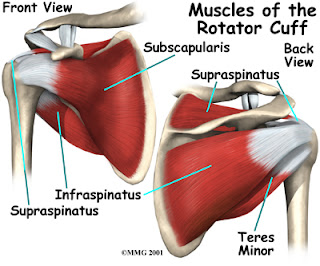*Cue drum roll*
The Rotator Cuff...
not cup
not cup
What exactly is the "Rotator Cuff"? Well first off... just because you see "cuff" in the singular sense, this particular guy is NOT. The rotator cuff is a combination of 4 different intrinsic muscles that stabilize the shoulder girdle.
Infraspinatus: primary functions are extension, horizontal (transverse) extension and lateral rotation of humerus at the shoulder joint. It is the major external rotator of the shoulder. When the arm is fixed, it abducts the inferior angle of the scapula. Its synergists are teres minor, subscapularis, and the deltoid. Additionally, the infraspinatus reinforces the capsule of the shoulder joint. The infraspinatus and teres minor rotate the head of the humerus outward (external, or lateral, rotation); they also assist in carrying the arm backward (extension of the glenohumeral joint).
Supraspinatus: muscle leads to abduction of the arm at the shoulder joint. It is the main agonist muscle for this movement during the first 10-15 degrees of its arc. Beyond 30 degrees the deltoid muscle becomes increasingly more effective at abducting the arm and becomes the main propagator of this action.
The supraspinatus muscle is one of the musculotendinous support structures of the rotator cuff that surround and enclose the shoulder. It helps to resist the inferior gravitational forces placed across the shoulder joint due to the downward pull from the weight of the upper limb.
The supraspinatus also helps to stabilize the shoulder joint by keeping the head of the humerus firmly pressed medially against the glenoid fossa of the scapula.
Teres minor : attach to head of the humerus (with Infraspinatus); as part of the rotator cuff they help hold the humeral head in the glenoid cavity of the scapula. They work in tandem with the posterior deltoid to externally (laterally) rotate the humerus, as well as perform adduction, extension and transverse extension.
All of these little guys are a HUGE important part of the shoulder.... Any of these guys go, so does your movement. Practice safe stretching of the shoulder, make sure that you warm up your shoulders as best you can before loading it, especially in movements like internal and external rotation ( like a baseball throw).
See a physician if you are having intense achey shoulder pain, especially if it prevents you from sleeping. That is usually a tall tale sign of a rotator cuff tear, or a tear of some sort in the shoulder joint.
Once again...always remember, its ROTATOR CUFF...not cup ;)




